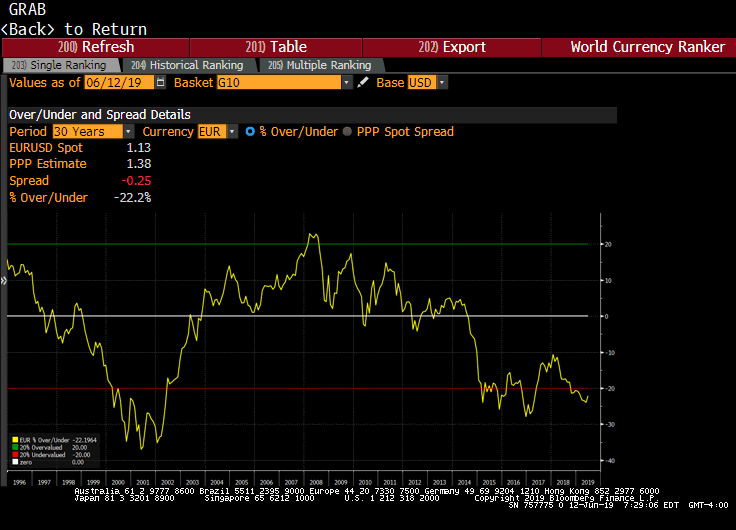| US President Trump recently bemoaned the fact that the euro is undervalued. While his critics complain that he is prone to exaggeration, in this case, the euro is undervalued. This Great Graphic a 30-year chart of the euro has moved around its purchasing power parity as measured by the OECD. Currently, the euro is about 22% undervalued, and it has been cheap to PPP since for the past five years. The OECD’s model suggests fair value for the euro is $1.38.
There are a few considerations needed to evaluate this significance. First, recall what purchasing power parity means? It essentially says that currencies should move to equalize a basket of traded goods. In effect, it is a level floating currencies should gravitate around in the long run. The euro has been below PPP for the past five years spending the previous decade above the OECD’s calculation. Before that, during the tech bubble, when the euro was born, it also spent several years below PPP. It may be helpful to think of PPP as “pound-for-pound” concept in sports. A smaller person might be said to be pound-for-pound stronger than a larger person. It is often claimed that an ant can lift 20-times its weight. Pound-for-pound, the ant, is much stronger than a human, but no one would confuse the claim as happens when China is said to be bigger than the US. |
Single Ranking, 1996-2019 |
Second, as I noted, PPP is the foreign exchange level that equalizes the price of tradeable goods. But, what if capital flows swamp trade flows by a huge factor. In effect, the exchange level needed to clear the goods market may be different than the exchange level required to clear the capital markets. It is clear why the clearing price for the goods market was emphasized in the 19th century but in the 21st?
Third, nearly all the currencies the OECD tracks are undervalued against the dollar. The exceptions are the Norwegian krone (~17.3%), the Swiss franc (~15.5%), and the Danish krone (~3.3%). Owing no small part to the role of the US verbal and material pressure, the Mexican peso is the most undervalued of the OECD currencies (~105%). It has not been less than 100% undervalued for four years. Fair value, according to the OECD’s model, is around MXN9.35. After the peso, the South Korean won is the second most undervalued OECD currency (~38.5%).
The euro is the most undervalued of the major currencies (~22.2%). Sterling is estimated to be about 14.1% cheap, while the yen is about 8.4% below its OECD PPP. The Canadian dollar is trading around 6.5% below where the OECD identifies fair value. The Australian dollar is less than an average daily range away from its fair value estimate.
Fourth, currency fluctuation is supposed to be an integral part of the self-adjustment process. A weaker economy experiences less aggregate demand, softening prices, and weighing on the currency, eventually making exports cheaper, increasing demand, and beginning the cycle again. The broad thinking about the liberalization of the capital markets was that if the price of money could adjust, absorb some of the shocks of the modern economy, then the real economy would not have to so much, and there can be longer and flatter business cycles.
Fifth, OECD currencies seem to rarely move beyond the PPP calculation by more than 25%. However, sometimes it appears that rather than the currency gravitate around PPP, PPP moves toward the currency, as over time a sustained misalignment impacts production and investment decisions. The euro had been as much as 28% undervalued in late 2016, and subsequent recovery did not see it become less than 10% undervalued. As macroeconomic forces are in play, and the price of money adjusts much quicker than the price of goods and services, extreme valuation takes time to correct as it did in 2000-2002. We think this process has already begun and coupled with the shifting US policy mix and the move interest rate differentials lie behind our call that the dollar’s third significant rally since the end of Bretton Woods is over.
Full story here Are you the author? Previous post See more for Next postTags: $EUR,Great Graphic,newsletter,PPP


























